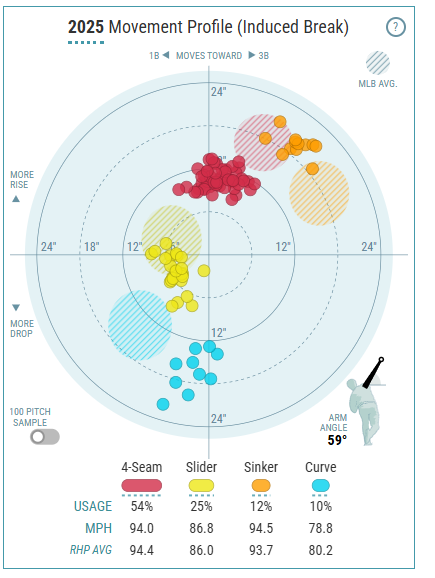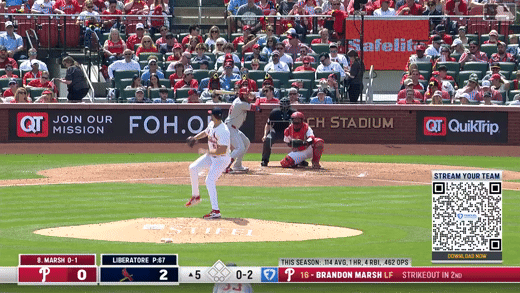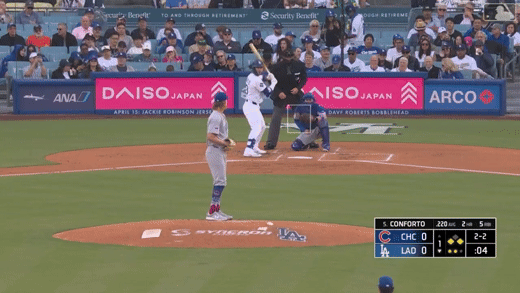Elliott looks at pitchers with surprising starts recently. These SPs could emerge as fantasy baseball waiver wire targets for Week 3 in 2025, or just mirages.
Welcome back to the "Are You For Real?" series as we dive into Week 3 of the 2025 fantasy baseball season. For those who are not familiar, this is a weekly column where we take starting pitchers who had surprisingly good starts over the past week and put them under the microscope to determine whether they're legit or just smoke and mirrors.
We're sticking in the NL Central this week, with three interesting arms to examine. First, we'll take a look at Andre Pallante dominating the Phillies. Then, we'll look at Matthew Liberatore, who also dominated the Phillies. We'll wrap it up by breaking down a strong start from Ben Brown against the Dodgers.
Roster percentages are taken from Yahoo! and are accurate as of April 14.
Be sure to check all of our fantasy baseball lineup tools and resources:- Fantasy baseball trade analyzer
- BvP matchups data (Batter vs. Pitcher)
- PvB matchups data (Pitcher vs. Batter)
- Who should I start? Fantasy baseball comparisons
- Daily MLB starting lineups
- Fantasy baseball closer depth charts
- Fantasy Baseball live scoreboard
- Fantasy baseball injury reports
Andre Pallante, St. Louis Cardinals - 7% Rostered
2024 Stats: 121 1/3 IP, 3.78 ERA. 3.71 FIP, 9% K-BB%
4/11 vs. PHI: 7 IP, 2 H, 0 ER, 2 BB, 4 K
Pallante continued his hot start to the season with his best start yet, putting up seven scoreless innings en route to his second victory of the season against Philadelphia on Friday. Pallante now has a 2.20 ERA through three starts and looks to be a permanent fixture in the Cardinals’ rotation. Does he belong in your fantasy rotation, or should we leave Pallante on the wire?
Initially a fourth-round draft pick out of UC Irvine in 2019, Pallante wasn’t much of a prospect coming up through the Cardinals’ system. He was viewed as a potential future starter, but as a backend arm. Pallante works with a four-pitch mix consisting of a four-seam fastball, slider, sinker, and knuckle curve.
Pallante may have four pitches at his disposal, but he relied primarily on two of them against the Phillies on Friday. He threw either his four-seam fastball or slider a combined 82 percent of the time, representing a shift for him compared to last season.
Last year, Pallante was four-seam heavy, but he also threw his sinker 19 percent of the time and his slider 17.2 percent of the time. He’s increased his slider usage to 24.7 percent this year and decreased his sinker usage to 11.8 percent. This approach could allow him to get more strikeouts as the slider is a much better strikeout weapon compared to the sinker.
Pallante has an incredible 51.6 percent whiff rate with his slider through three starts, compared to an 11.1 percent whiff rate on his sinker. I wouldn’t expect him to maintain a 51.6 percent whiff rate with his slider all season, as it was just 28.2 percent last year, but an increase in slider usage is a positive development for Pallante’s strikeout potential.
Pallante has never been a strikeout guy, but he does boast above-average vertical movement with his slider, and batters are hitting just .071 off the pitch this season. Don’t expect significant gains in the strikeout department, but he could probably maintain a 19-20 percent strikeout rate with this approach.
The real gem of Pallante’s repertoire is his four-seam fastball. It has 20.3 inches of vertical drop, making it incredibly difficult for hitters to square up, and Pallante is a groundball machine as a result. Have a look at that four-seam fastball shape.

It’s no wonder that batters swing over it; it’s got a very deceptive shape thanks to exceptional vertical movement. Opponents have a -5-degree average launch angle against Pallante’s four-seam fastball this season.
That number almost seems unsustainable, but Pallante actually had a -6-degree average launch angle against last season in 121 1/3 innings. He also had a 61.8 percent ground-ball rate last year, the highest among all pitchers (min. 120 innings). He has an incredible 69.6 percent ground-ball rate this year so far, and while I wouldn’t expect him to maintain that, he should have one of the highest ground-ball rates in MLB.
Pallante has been both lucky and unlucky thus far, and while he’s sporting a cool 2.20 ERA, his 4.58 xERA and 4.27 FIP may scare some managers off. Advanced metrics don’t tend to like pitch-to-contact groundball specialists like Pallante, but there’s a chance he could outperform those metrics.
He’s been lucky in the sense that Pallante has allowed a .182 BABIP and has a 91.5 percent strand rate; there’s no way either of those lasts. He’s been unlucky in the home run department, having served up two bombs in three starts with a bloated 25 percent HR/FB ratio.
That number should normalize, and the bloated HR/FB rate is why Pallante’s 3.38 xFIP is so much better than his 4.27 FIP. xFIP normalizes for home-run rate, thinking most pitchers' HR/FB rates will settle in around league average.
I know Pallante can’t maintain his 2.20 ERA, and I find it unlikely that he has an ERA around the 3.38 mark either. Pallante’s best hope is probably a year similar to last season: a sub-4 ERA with lots of groundballs and a mediocre strikeout rate. He doesn’t have the best control, so he could also be a WHIP liability.
Verdict:
Pallante is doing some interesting things on the mound. He has an exceptional four-seam fastball, allowing him to put up elite groundball numbers. He’s got an improved whiff rate on his slider this season, which could lead to more strikeouts, but thus far, the gains have been minimal.
He does have some considerable drawbacks. He issues a lot of walks and surrenders a lot of contact, so he may have a bloated WHIP.
His ERA could stay under four like last season, but don’t expect it to be too much lower than 3.78. He pitches for a middling team that won’t give him many win opportunities (though he already has two).
He’s been incredibly lucky with a .182 BABIP against and a 91.5 percent LOB rate, both of which will inevitably normalize towards league average. He’s fine in a spot start against weak competition, but he’s not much more than a streamer for standard leagues.
Matthew Liberatore, St. Louis Cardinals - 6% Rostered
2024 Stats: 86 IP, 4.40 ERA, 4.11 FIP, 13.4% K-BB%
4/13 vs. PHI: 6 IP, 3 H, 0 ER, 1 BB, 7 K
Liberatore was fantastic on Sunday, blanking the Phillies for six innings while picking up his first victory of the season. Liberatore now has a 3.93 ERA and a 1.91 FIP through his first three starts. A former top prospect, is there any value to be had with Liberatore, or is he a Libera-bore?
Originally a first-round pick back in 2018 by Tampa Bay, Liberatore was once considered one of the best pitching prospects in baseball. He struggled at the higher levels of the minor leagues, causing his prospect pedigree to dip. He was also putrid as a major leaguer before last season.
In 96 1/3 innings, Liberatore put up a 5.51 ERA, 4.54 FIP, and 7.1 percent K-BB rate between 2022-23. His poor performance had us doubting not only if Liberatore would ever reach his massive potential, but also if he deserved to be in the majors as a starter. He was a little better last season, working primarily out of the bullpen, but can Liberatore be a fantasy-relevant starter?
Liberatore works with a deep six-pitch arsenal consisting of a four-seam fastball, slider, changeup, sinker, curveball, and cutter. He threw all six pitches at least eight percent of the time against Philadelphia, and for the most part, has done a good job of mixing in all six pitches as a major leaguer.
Liberatore’s standout pitch is probably his slider, which he threw 34 percent of the time in this one, his most-used pitch. Liberatore had some impressive results with the pitch as well, notching 11 of his 14 whiffs on the slider, good for a 65 percent whiff rate. Liberatore has above-average vertical movement with the slider, giving it a loopy, drastic movement pattern. Here’s an example from this start.

It looks pretty filthy there, and Liberatore also has an above-average spin with the slider at 2703 RPM. It has good deceptiveness and could be a nice swing-and-miss pitch for Liberatore. Liberatore had a 21.7 percent swinging-strike rate with the pitch last season, and has a 27.3 percent swinging-strike rate with it thus far.
Liberatore put up some strong strikeout numbers in the minors, and while I wouldn’t expect him to near 30 percent like he did during his last stint at Triple-A in 2023, I think a 25 percent strikeout rate is in the realm of possibility for Liberatore. Liberatore has increased his slider usage in each successive start this season, and I’d like to see his usage stay around the 25-35 percent range.
He has a lot of pitches to choose from, but the slider seems like his best.
Liberatore’s next most-used pitch in this start was his four-seam fastball. A 94.2 mph heater, Liberatore has average movement and spin with the pitch, giving it a rather typical shape. Batters have had no trouble with Liberatore’s four-seamer, posting a .275 AVG and .495 SLG off the pitch historically.
He’s been better this season with a .217 AVG and .348 SLG against, but he’s not really doing anything differently with the pitch. It has the same velocity and movement, and he’s locating it the same. He has a .216 BABIP against his fastball this season, and I expect that number to rise. Ultimately, Liberatore’s fastball is painfully average and will have commensurate results.
Liberatore’s changeup was on display in this start as well, with the lefty using it 15 percent of the time against Philadelphia. He only used it 4.4 percent of the time last season, so this is a change in pitch mix for Liberatore. With an 89.1 mph offering, Liberatore’s changeup has a relatively high spin at 1759 RPM, and there isn’t a large gap between his fastball and changeup velocity, just five mph.
He has just a 3.4 percent swinging-strike rate with the pitch this season and had just an 8.3 percent swinging-strike rate with it last season. The pitch is a workable third option, but Liberatore’s changeup doesn’t appear to be anything special either.
Something that Liberatore is doing well thus far is limiting walks. Control has long been an issue for Liberatore, though his walk rate has lowered in each major league season. There’s no way he sustains his current 1.4 percent walk rate, but this is a great improvement to see.
Even if his current walk rate quadruples, it’ll be an improvement. He isn’t throwing more strikes, but he is getting more chases. Liberatore has a 35 percent chase rate this season compared to a 26.5 percent career mark. If he can get hitters to chase his sliders and high heat, then he could cut down on the walks overall, leading to a better WHIP and hopefully better ERA.
Verdict:
This writer was undoubtedly ready to write Liberatore off after his struggles in the minors, disastrous start to his MLB career, and a middling bullpen season in 2024. But Liberatore is showing us he might be a big league starter after all. His best pitch is his slider, and he’s begun throwing it more frequently.
He used it 34 percent of the time against Philadelphia, his second-highest usage ever in a start. It would be nice to see his slider usage stay between 25-35 percent, as it’s his best pitch and best bet at strikeouts.
The rest of his arsenal lacks exceptionality and will likely be handled by MLB hitters. He can probably skirt by with his average fastball and changeup, so long as he leans on the slider. Overall, Liberatore has some upside but is a rather risky bet. If he doesn’t have the slider, he's liable to get knocked around, and he hasn’t shown us enough positives to be trustworthy outside of streaming.
Ben Brown, Chicago Cubs - 9% Rostered
2024 Stats: 55 1/3 IP, 3.58 ERA, 3.11 FIP, 20.3% K-BB%
4/12 @ LAD: 6 IP, 5 H, 0 ER, 0 BB, 5 K
Brown was excellent on Saturday, blanking the almighty Dodgers over six innings en route to his second victory of the season. Maybe we shouldn’t be surprised by an excellent start from Brown, given his 2024 numbers. He was dominant with a 3.11 FIP and 20.3 percent K-BB rate in 15 appearances last season.
But he’s struggled outside of his most recent start, putting up a 7.71 ERA through his first three appearances of 2025. Brown has flashed some big upside, but also has proven rather volatile as a starter. Is there a reliable MLB starter developing here, or is he too much of a risk to bear?
Originally a 33rd-round pick by the Phillies back in 2017, Brown wasn’t much of a prospect coming up, though he was a key return piece in a David Robertson trade in 2022, which is how he came to Chicago. Brown works with a two-pitch mix.
Yes, you read that right, a two-pitch mix consisting of a four-seam fastball and knuckle curve. He has technically thrown eight changeups this season, but Brown is a two-pitch pitcher for all intents and purposes. So, how good is the stuff?
His fastball has an above-average velocity of 95.4 mph, but it has rather average spin and movement, giving it a typical shape. His velocity is down this season, as he averaged 96.4 mph with it last year. Brown’s fastball doesn’t seem all that deceptive, and opponents are hitting .350 with a .400 SLG and .394 wOBA against it this year.
Last season, opponents hit .250 with a .352 SLG and a .307 wOBA, but batters also had a .296 xBA, .511 xSLG, and .401 xwOBA off Brown’s fastball. Plus, they were scorching the ball for a 92.2 mph average exit velocity and an 18-degree average launch angle against.
The exit velocity and launch angle have both improved this season to 88.9 mph and five degrees, respectively, but it’s too small of a sample size to draw significant conclusions from yet.
The fastball may be his most-used pitch, but Brown’s best pitch has got to be his knuckle curve. An 86 mph offering, Brown’s knuckle curve is harder than your typical curveball and has exceptional drop and break, making it ultra-deceptive to major league hitters. Here’s an example from this start.

It’s loopier and has more downward movement than a slider, but harder than a normal curveball. Opponents have struggled against this pitch, hitting .235 with a .412 SLG and .305 wOBA, including a .235 xBA, .399 xSLG, and .292 xwOBA against.
He has a monster 22 percent swinging-strike rate with the pitch this season, and had a 24.8 percent swinging-strike rate with it last year. Brown’s knuckle curve looks like a bona fide strikeout pitch, which could rack up whiffs and strikeouts when everything is right.
What’s really missing from Brown’s repertoire is a third pitch. If he had a show-me changeup that he throws more than two percent of the time, it could help him take off. The potential is here, and Brown had some impressive numbers during his rookie season.
The knuckle curve is legit, and he at least throws hard enough to get by with a straight fastball. It’s just so hard to trust a two-pitch pitcher outside of soft matchups. We’ve seen many pitchers try to make it with two offerings, but few do.
Verdict:
Brown had some impressive numbers during his rookie season, and Saturday seemed like a peak Brown start. His fastball was popping, and he got six whiffs with his knuckle curve. The fastball is passable thanks to plus velocity, and the knuckle curve looks like a pitch to behold.
It has standout whiff numbers and has routinely given Brown plus strikeout rates. There is big potential here, but we’d like to see Brown develop a third pitch. Two-pitch pitchers are risky, volatile, and often short-lived. For now, Brown should be viewed as a high-risk streamer, but if he ever develops his changeup or another pitch, look out.
Download Our Free News & Alerts Mobile App
Like what you see? Download our updated fantasy baseball app for iPhone and Android with 24x7 player news, injury alerts, sleepers, prospects & more. All free!

More Fantasy Baseball Advice
 RADIO
RADIO
























